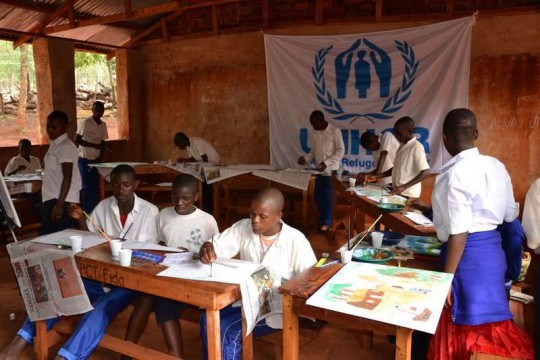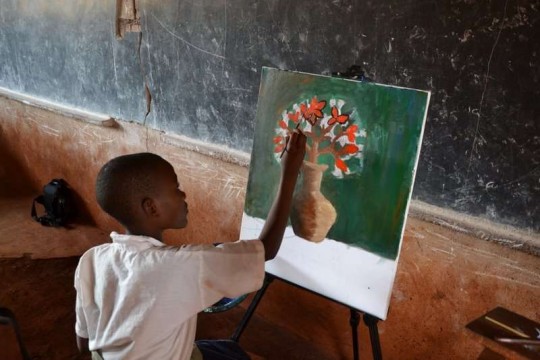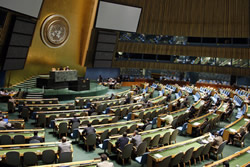Refugee children in Tanzania learn art basics in UN-sponsored workshop
Refugee children in Tanzania learn art basics in UN-sponsored workshop
 Congolese refugees and local Tanzanian children learn about art techniques side by side. Photo: UNHCR/S.Starke
Congolese refugees and local Tanzanian children learn about art techniques side by side. Photo: UNHCR/S.Starke
1 February 2012 – In a novel way to impart new skills to children while improving their social interaction, the United Nations refugee agency has sponsored an arts workshop for refugee pupils from the Democratic Republic of the Congo (DRC) in Tanzania, where they were introduced to the basics of painting with water colours, pastels and acrylics and making collages.
About 140 pupils from primary and secondary schools, 100 of them Congolese from the Nyarugusu refugee camp in north-western Tanzania attended last week’s course, organized by the UN High Commissioner for Refugee (UNHCR) and the Ujamaa Art Gallery based in Dar es Salaam, Tanzania’s commercial capital.
“This is like fresh air for the refugee children. They are excited,” said Belgian art teacher Soline de Laveleye, who conducted the workshop with three of Tanzania’s top artists – Obadia Mbise, Thobias Minzi and Haji Chilonga. “They help each other and are keen to share their experiences. Some are even making new friends,” she said.
The initiative is the first of its kind in Nyarugusu refugee camp, but UNHCR and the Ujamaa Art Gallery are considering continuing the project and incorporating other art forms, such as drama, music and literature.
“This project has brought the two groups [refugees and Tanzanians] closer together and fostered their interaction,” said Oluseyi Bajulaiye, UNHCR’s representative in Tanzania.
Baraka Danford, 16, said: “This is like magic, it is a big gift to me,” adding that he had never used colours before but could sketch.
The youngsters painted and drew, experimenting with line, colour, shadow and light. Some depicted the things they saw around them, while many delved into their traumatic past for inspiration, including images of soldiers and guns in DRC.
An exhibition of the best works created by the young Congolese and Tanzanians at the workshop will go on display starting 15 February at the Ujamaa Art Gallery.
Proceeds from the sale of paintings, drawings and collages will be used to organize more art and educational projects to benefit refugees and host communities.
“These kids are hungry for it and we would like to give them a chance to develop their skills and make a positive impact in their life,” Larna Mashiba, the gallery’s director.
###
Art project brings together Congolese refugees and Tanzanian students
1 February 2012
NYARUGUSU REFUGEE CAMP, Tanzania, February 1 (UNHCR) –Himidi stood back from the canvas and, brush in hand, looked with a critical eye at his work. “I decided to draw a waterfall and a bridge, because when disaster strikes, towns and countries are torn apart– bridges can connect them,” he noted, adding: “I think that people can create bridges through relations.”
 A young artist works on her still life of a vase of flowers.
A young artist works on her still life of a vase of flowers.
That, essentially, was the point of the art workshop that he took part in last week in Nyarugusu Refugee Camp in north-west Tanzania. The budding artist joined about 140 other students in the course, which was organized by the UN refugee agency and the Ujamaa Art Gallery in Dar Es Salaam.
Around 100 of the young people were Congolese refugees studying at primary and secondary schools in Nyarugusu, while the rest were from local host communities. Together, they learned about how to use water colours, pastels and acrylics and how to make collages.
Leading the workshop were Belgian art teacher Soline de Laveleye and three of Tanzania’s top artists: Obadia Mbise, Thobias Minzi and Haji Chilonga. They were impressed by the childrens’ talent and their eagerness to learn as well as by the spirit of cooperation between the refugees and local children.
“This is like fresh air for the refugee children. They are excited. But also the Tanzanian students are very involved,” said de Laveleye. “They help each other and are keen to share their experiences. Some are even making new friends,” she noted.
“I have never coloured before, I only knew how to sketch,” revealed 16-year-old Baraka Danford, who said he hopes to become a professional artist. “This is like magic, it is a big gift to me,” added the excited teenager, who paid careful attention to the teachers, anxious to take in everything.
The young students carried on painting and drawing during the breaks and after the day’s class was over, experimenting with line, colour, shadow and light. Some depicted the things they saw around them, while many of the refugees delved into their traumatic past for inspiration, including images of soldiers and guns in the Democratic Republic of the Congo.
“This project has brought the two groups [refugees and Tanzanians] closer together and fostered their interaction,” said Oluseyi Bajulaiye, UNHCR’s representative in Tanzania. “We can see how imaginative the children are and how their life gets colourful through art. They are used to playing with dirt,” added Sunil Thapa, head of the UNHCR office in the nearby town of Kasulu.
The initiative is the first of its kind to be carried out in Nyarugusu Refugee Camp, but UNHCR and the Ujamaa Art Gallery hope the programme can continue and incorporate other art forms such as drama, music and literature.
An exhibition of the best works created by the young Congolese and Tanzanians at the workshop here in Nyarugusu will go on display from February 15 at the Ujamaa Art Gallery.
The gallery’s director, Lorna Mashiba, said proceeds from the sale of paintings, drawings and collages would be used to organize more art and educational projects to benefit refugees and host communities. “These kids are hungry for it and we would like to give them a chance to develop their skills and make a positive impact in their life,” she explained.
By Sabine Starke in Dar es Salaam, Tanzania
###
About Office of the United Nations High Commissioner for Human Rights (OHCHR)
Who we are
The Office of the United Nations High Commissioner for Human Rights (OHCHR) represents the world’s commitment to universal ideals of human dignity. We have a unique mandate from the international community to promote and protect all human rights.
Leadership
The High Commissioner for Human Rights is the principal human rights official of the United Nations. The High Commissioner heads OHCHR and spearheads the United Nations’ human rights efforts. We offer leadership, work objectively, educate and take action to empower individuals and assist States in upholding human rights. We are a part of the United Nations Secretariat with our headquarters in Geneva.
The Office’s priorities are set out in two key strategic documents: the OHCHR Plan of Action and its Strategic Management Plan 2010-2011. These priorities include greater country engagement, working closely with our partners at the country and local levels, in order to ensure that international human rights standards are implemented on the ground; a stronger leadership role for the High Commissioner; and closer partnerships with civil society and United Nations agencies.
United Nations human rights system
We also support the work of the United Nations human rights mechanisms, such as the Human Rights Council and the core treaty bodies set up for monitoring State Parties’ compliance with international human rights treaties, promote the right to development, coordinate United Nations human rights education and public information activities, and strengthens human rights across the United Nations system. We work to ensure the enforcement of universally recognized human rights norms, including through promoting both the universal ratification and implementation of the major human rights treaties and respect for the rule of law.
Our structure
We have an office at United Nations headquarters in New York and offices in numerous countries and regions. In addition to the Executive Office of the High Commissioner and a number of units that report to the Deputy High Commissioner, OHCHR has two major divisions and four branches.
To implement our comprehensive mandate, we employ more than 850 staff (last update in April 2007), based in Geneva and New York and in 11 country offices and seven regional offices around the world, including a workforce of some 240 international human rights officers serving in UN peace missions. We are funded from the United Nations regular budget and from voluntary contributions from Member States, intergovernmental organizations, foundations and individuals.
###
> United Nations (UN).
 The United Nations was established on 24 October 1945 by 51 countries committed to preserving peace through international cooperation and collective security. Today, nearly every nation in the world belongs to the UN: membership totals 192 countries.
The United Nations was established on 24 October 1945 by 51 countries committed to preserving peace through international cooperation and collective security. Today, nearly every nation in the world belongs to the UN: membership totals 192 countries.
When States become Members of the United Nations, they agree to accept the obligations of the UN Charter, an international treaty that sets out basic principles of international relations. According to the Charter, the UN has four purposes:
- to maintain international peace and security;
- to develop friendly relations among nations;
- to cooperate in solving international problems and in promoting respect for human rights;
- and to be a centre for harmonizing the actions of nations.
###
* The above story is adapted from materials provided by United Nations (UN)
** More information at United Nations (UN)




















